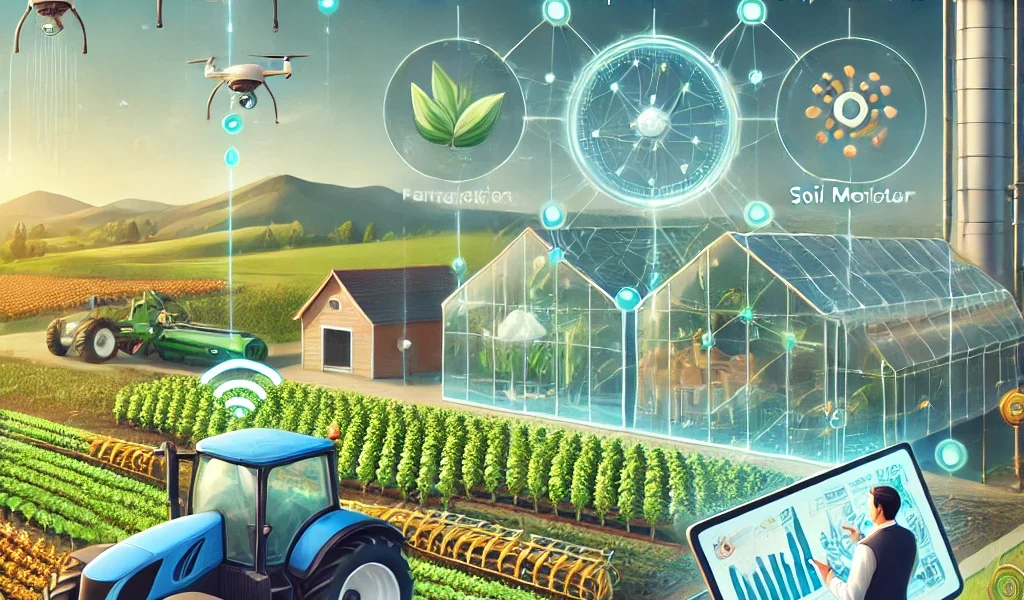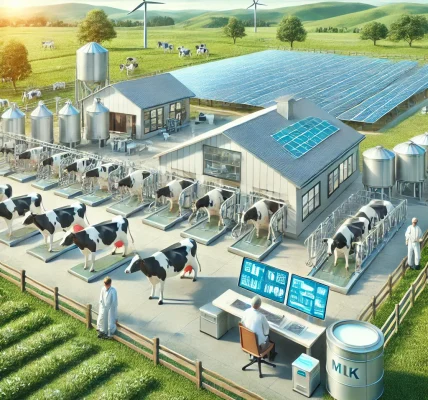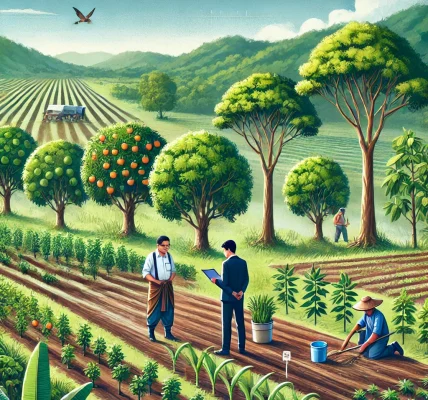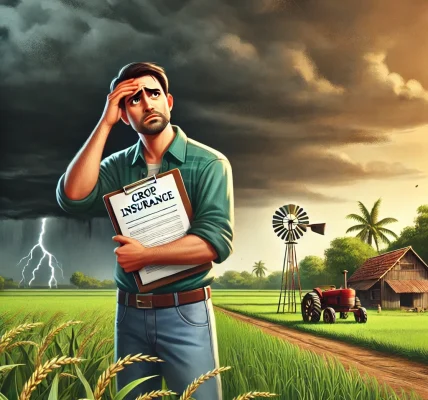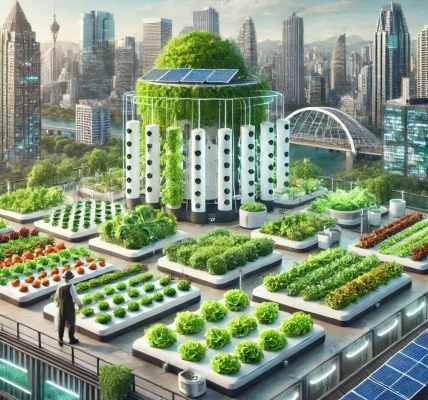Introduction
Agriculture is the backbone of India’s economy, contributing significantly to GDP and employment. However, the sector faces multiple challenges, including unpredictable weather, inefficient resource use, and post-harvest losses. To address these issues, Artificial Intelligence (AI) and the Internet of Things (IoT) are emerging as game changers, helping farmers optimize productivity and reduce risks.
Recognizing the potential of AI and IoT in agriculture, the Indian government has launched several initiatives and policies to promote smart farming. These digital transformations are making farming more efficient, sustainable, and profitable.
In this article, we explore how AI and IoT are revolutionizing agriculture with government support, and how farmers can benefit from these advancements.
The Role of AI and IoT in Agriculture
1. AI in Agriculture: Enhancing Decision-Making
Artificial Intelligence helps farmers make better decisions by analyzing large datasets and providing actionable insights. Key applications of AI in agriculture include:
- Predictive Analytics: AI-powered models analyze weather patterns, soil health, and crop diseases to predict potential threats and suggest preventive measures.
- Automated Crop Monitoring: AI-driven drones and satellite imagery monitor crop growth, pest infestations, and nutrient levels in real time.
- Smart Irrigation Systems: AI-based irrigation controllers optimize water usage by predicting the exact water requirements of crops.
- Market Price Forecasting: AI algorithms analyze market trends to help farmers get the best prices for their produce.
2. IoT in Agriculture: Connecting Farms to Smart Systems
IoT refers to a network of connected devices that collect and share real-time data. In agriculture, IoT applications include:
- Precision Farming: Sensors placed in fields collect data on soil moisture, temperature, and nutrient levels, enabling precise application of fertilizers and water.
- Livestock Monitoring: IoT-enabled wearable devices help track the health and movement of cattle, reducing disease outbreaks and losses.
- Smart Greenhouses: IoT-based automation controls temperature, humidity, and light to optimize plant growth without human intervention.
- Supply Chain Management: IoT solutions track the movement of agricultural produce, ensuring quality control and reducing wastage.
By integrating AI and IoT, farmers can make informed decisions, reduce costs, and increase crop yield, ultimately improving their income and sustainability.
Government Support for AI and IoT in Agriculture
To encourage digital transformation in agriculture, the Indian government has introduced various initiatives and policies. Here are some key programs:
1. Digital Agriculture Mission (2021-2025)
The Digital Agriculture Mission aims to leverage AI, IoT, blockchain, and other technologies to improve agricultural productivity. The mission focuses on:
- Promoting AI-based solutions for crop monitoring and yield prediction.
- Implementing IoT-based soil and water management systems.
- Encouraging startups to develop smart farming technologies.
2. National e-Governance Plan in Agriculture (NeGPA)
NeGPA promotes the use of technology in agriculture by:
- Establishing a centralized digital platform for farmers to access weather forecasts, market prices, and government schemes.
- Implementing AI-powered crop advisories to help farmers make data-driven decisions.
- Developing mobile apps for precision farming and digital land records.
3. AgriStack Initiative
AgriStack is a digital database that integrates farm-related data for better decision-making. It aims to:
- Provide farmers with real-time insights on soil health, weather conditions, and pest outbreaks.
- Facilitate digital payments and direct benefit transfers (DBT) for government subsidies.
- Support AI-driven recommendations for crop selection and best practices.
4. Pradhan Mantri Krishi Sinchayee Yojana (PMKSY) and AI-Based Irrigation
Under PMKSY, AI-powered smart irrigation systems are being introduced to:
- Optimize water usage by predicting crop water requirements.
- Reduce water wastage and improve irrigation efficiency.
- Promote the adoption of IoT-based automated irrigation controllers.
5. Smart Agriculture Grant by NITI Aayog
NITI Aayog has launched pilot projects to explore AI and IoT applications in farming, including:
- AI-powered soil testing kits for precise fertilizer recommendations.
- IoT-enabled weather stations for real-time climate monitoring.
- Drone-based crop surveys to assess field conditions.
These initiatives highlight the government’s commitment to transforming agriculture through AI and IoT, making farming smarter and more profitable.
Benefits of AI and IoT in Agriculture
The adoption of AI and IoT in agriculture offers numerous advantages:
1. Increased Crop Yield
- AI-driven precision farming reduces resource wastage and enhances productivity.
- IoT-based sensors ensure optimal soil conditions for better crop growth.
2. Reduced Operational Costs
- Smart irrigation and automated machinery lower water and fuel consumption.
- AI-based pest detection minimizes the need for chemical pesticides, reducing costs.
3. Early Disease Detection
- AI-powered imaging systems identify crop diseases before they spread.
- IoT-enabled livestock monitoring detects early signs of illness, preventing mass outbreaks.
4. Efficient Resource Utilization
- AI algorithms analyze soil conditions to recommend precise fertilizer application.
- IoT sensors monitor water levels, ensuring efficient irrigation management.
5. Improved Market Access
- AI-driven market predictions help farmers sell their produce at the best prices.
- IoT-enabled supply chain tracking ensures better logistics and reduces wastage.
Challenges and Solutions in Implementing AI and IoT in Agriculture
Challenges:
- High Initial Investment: Many small farmers cannot afford advanced AI and IoT tools.
- Lack of Digital Literacy: Farmers need proper training to use smart farming technologies.
- Connectivity Issues: Rural areas often lack reliable internet access for IoT devices.
- Data Privacy Concerns: Protecting farmers’ data from misuse is a significant challenge.
Proposed Solutions:
- Government Subsidies and Loans: Offering financial aid to help farmers adopt AI and IoT.
- Training and Awareness Programs: Conducting workshops on digital farming techniques.
- Rural Internet Expansion: Improving network infrastructure for better connectivity.
- Data Protection Policies: Ensuring strict regulations to safeguard farmers’ information.
Future of AI and IoT in Indian Agriculture
The future of AI and IoT in agriculture is promising, with continuous advancements and increased government support. Some upcoming trends include:
- Autonomous Farming Equipment: AI-powered tractors and drones will reduce labor dependency.
- Blockchain-Based Supply Chains: Enhancing transparency and efficiency in agricultural trade.
- AI-Driven Weather Prediction Models: Providing more accurate forecasts to prevent crop losses.
- IoT-Based Smart Farming Networks: Connecting multiple farms for data sharing and collaborative decision-making.
With sustained government initiatives and technological advancements, AI and IoT will continue to reshape Indian agriculture, making it more efficient, sustainable, and resilient.
Conclusion
AI and IoT are revolutionizing Indian agriculture by improving productivity, reducing risks, and enhancing resource efficiency. With strong government backing through initiatives like Digital Agriculture Mission, NeGPA, and AgriStack, farmers have access to cutting-edge technologies that make farming smarter and more profitable.
To fully realize the benefits, farmers must embrace digital transformation and leverage AI and IoT solutions for sustainable growth. The future of agriculture is digital, and India is well on its way to becoming a global leader in smart farming.
